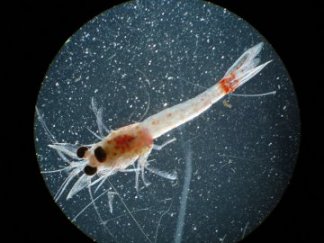Shrimpy invaders
A shrimplike creature that has invaded the Great Lakes could spell big trouble for young fish.
By Emily Sohn
A new type of shrimplike crustacean has appeared in the Great Lakes, and that’s not necessarily a good thing.
 |
|
This tiny European mysid shrimp, about a half-inch long, could spell big problems for the Great Lakes, where it’s just been spotted.
|
| Steven Pothoven, NOAA, Great Lakes Environmental Research Laboratory |
These crustaceans, called mysid shrimp, normally live in rivers near the western coast of the Caspian Sea in eastern Europe. In November, researchers from the National Oceanic and Atmospheric Administration (NOAA) found invading mysid shrimp in a channel in Lake Michigan. Now, NOAA reports that large numbers of the animal, called Hemimysis anomala, are living in southeastern Lake Ontario.
“I predict it will be a highly disruptive species,” says Anthony Ricciardi of McGill University in Montreal.
Mysid shrimp devour microscopic animals, which many young fish in the Great Lakes also eat. A heavy dose of new competition for food may harm fish populations.
The invasion is not a total surprise. From the 1970s through the 1990s, many creatures from the same area of eastern Europe entered the Great Lakes in ships that carry seawater to help keep them stable. This water is called ballast water. It’s often dumped as ships load and unload cargo wherever they happen to be.
In 1998, Ricciardi and a colleague came up with a list of 17 more European species that would probably arrive next. Hemimysis was on this list.
Although most European ships entering the Great Lakes now dump nearly all the water (and the critters living in it) from their ballast tanks before leaving Europe, a small amount still remains on board. That’s still enough water to harbor species such as Hemimysis anomala. This water can end up in the Great Lakes while ships unload and take on cargo.
New guidelines recommend that ships flush their tanks with saltwater before entering the Great Lakes. This “swish and spit” technique should be enough to kill any freshwater species that have come along for the ride.
It’s not yet clear how Hemimysis will affect Great Lakes ecosystems. Larger fish might find the shrimp appetizing, but these fish could then become more toxic to people. Mysid shrimp are fatty, so they can collect high doses of pollutants in their bodies. These pollutants then work their way up the food chain.
H. anomala look small and innocent, but don’t underestimate their ability to shake things up. “This is not,” Ricciardi says, “a species to ignore.”
Going Deeper:
Raloff, Janet. 2007. Alien alert: Shrimpy invader raises big concerns. Science News 171(Jan. 13):20. Available at http://www.sciencenews.org/articles/20070113/fob3.asp .
You can learn more about the mysid shrimp known as Hemimysis anomala at www.glerl.noaa.gov/pubs/photogallery/Hemimysis.html (NOAA) and www.grid.unep.ch/bsein/redbook/txt/hemimysa.htm (United National Environment Programme).
Sohn, Emily. 2005. Smelly traps for lampreys. Science News for Kids (Nov. 16). Available at http://www.sciencenewsforkids.org/articles/20051116/Note2.asp .
______. 2004. Alien invasions. Science News for Kids (May 12). Available at http://www.sciencenewsforkids.org/articles/20040512/Feature1.asp .
ScienceFairZone
Regrowth after Wildfires
http://www.sciencenewsforkids.org/articles/20070103/ScienceFairZone.asp
Invading Bark Beetles
http://www.sciencenewsforkids.org/articles/20060920/ScienceFairZone.asp
Eradicating the Giant Cane Plant
http://www.sciencenewsforkids.org/articles/20051116/ScienceFairZone.asp
Combating Daylily Rust
http://www.sciencenewsforkids.org/articles/20050309/ScienceFairZone.asp
Effects of Fires on Saltcedar Growth
http://www.sciencenewsforkids.org/articles/20040428/ScienceFairZone.asp







